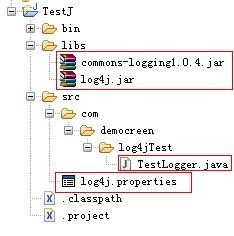Log4j---Why You Should Use “isDebugEnabled” ?
使用log4j,common-log这样的log框架时,发现很多代码中这样写
if (log.isDebugEnabled ()) {
log.debug( "xxxx ");
}
我很奇怪,为什么要与log.isDebugEnabled ()?既然log.debug()在没有指定输出级别为DEBUG时不会有输出,为什么还要在前面加一个isDebugEnabled ()的判断?
~~~~~~~~~~~~~~~~~~~~~~~~~~~~~~~~~~~~~~~~~~~~~~~~~~~~~~~~~~~~~~~~~~~~~~~~~~~
写了一个测试。
工程如下,如果你想明白到底怎么回事,那么你跑起来,你就明白了。
log4j.properties
log4j.rootLogger=info, stdout log4j.appender.stdout=org.apache.log4j.ConsoleAppender log4j.appender.stdout.layout=org.apache.log4j.PatternLayout log4j.appender.stdout.layout.ConversionPattern=%d %p [%c] - %m%n
TestLogger.java
package com.democreen.log4jTest; import org.apache.commons.logging.Log; import org.apache.commons.logging.LogFactory; public class TestLogger { // Logging object protected Log log = LogFactory.getLog(TestLogger.class); private void withoutCheck() { long startTime = System.currentTimeMillis(); for (int i = 0; i < 10000000; i++) { log.debug("this is a test"); } System.out.println( ((System.currentTimeMillis() - startTime)) + " milliseconds"); } private void withCheck() { long startTime = System.currentTimeMillis(); for (int i = 0; i < 10000000; i++) { if (log.isDebugEnabled()) log.debug("this is a test"); } System.out.println( ((System.currentTimeMillis() - startTime)) + " milliseconds"); } private void newCheck() { long startTime = System.currentTimeMillis(); for (int i = 0; i < 10000000; i++) { if (log.isDebugEnabled()) log.debug("this " + " is " + " a " + " test"); } System.out.println( ((System.currentTimeMillis() - startTime)) + " milliseconds"); } public static void main(String[] args) { TestLogger testLogger = new TestLogger(); testLogger.withoutCheck(); testLogger.withCheck(); testLogger.newCheck(); } }
运行结果:
~~~~~~~~~~~~~~~~~~~~~~~~~~~~~~~~~~~~~~~~~~~~~~~~~~~~~~~~~~~~~~~~~~~~~~~
查看源码:
我下载了log4j的源代码,apache-log4j-1.2.15.zip。
![]()
log.class
![]()
![]()
~~~~~~~~~~~~~~~~~~~~~~~~~~~~~~~~~~~~~~~~~~~~~~~~~~~~~~~~~~~~~~~~~~~~~~
稍作解释:
log打印级别次序:
debug info warn error fatal
如果是log4j.rootLogger=debug ,CONSOLE,FILE 则会把debug以及后面的级别都打印出来。如果是info,那么debug就出不来了,这个有等级的。
分析:可以看出,在debug方法内部,也先进行了log级别的判断。
显然,在使用这个debug方法之前,首先要将参数message构筑好。这也是先使用isDebugEnabled 方法进行判断的目的。
在前面加不加这句if判断,结果是一样的,但是效率可能有所差别:
当输出级别是debug,即需要进行日志信息输出时,加不加这句if判断,在效率上几乎没有差别;
当输出级别高于debug,即不需要进行日志信息输出时:
①假如debug方法中的参数比较简单时(比如直接就是写好的字符串),加不加这句if判断,在效率上也几乎没有什么差别;
②假如debug方法中的参数比较复杂时(比如还要使用别的函数进行计算、或者还要进行字符串的拼接等等),在前面就加上这句if判断,会让效率提高(否则,开始大动干戈做了很多事情(比如字符串的拼接),后来才发现不需要进行输出日志信息)。
问题很简单,动手才明白原来是这么回事。



